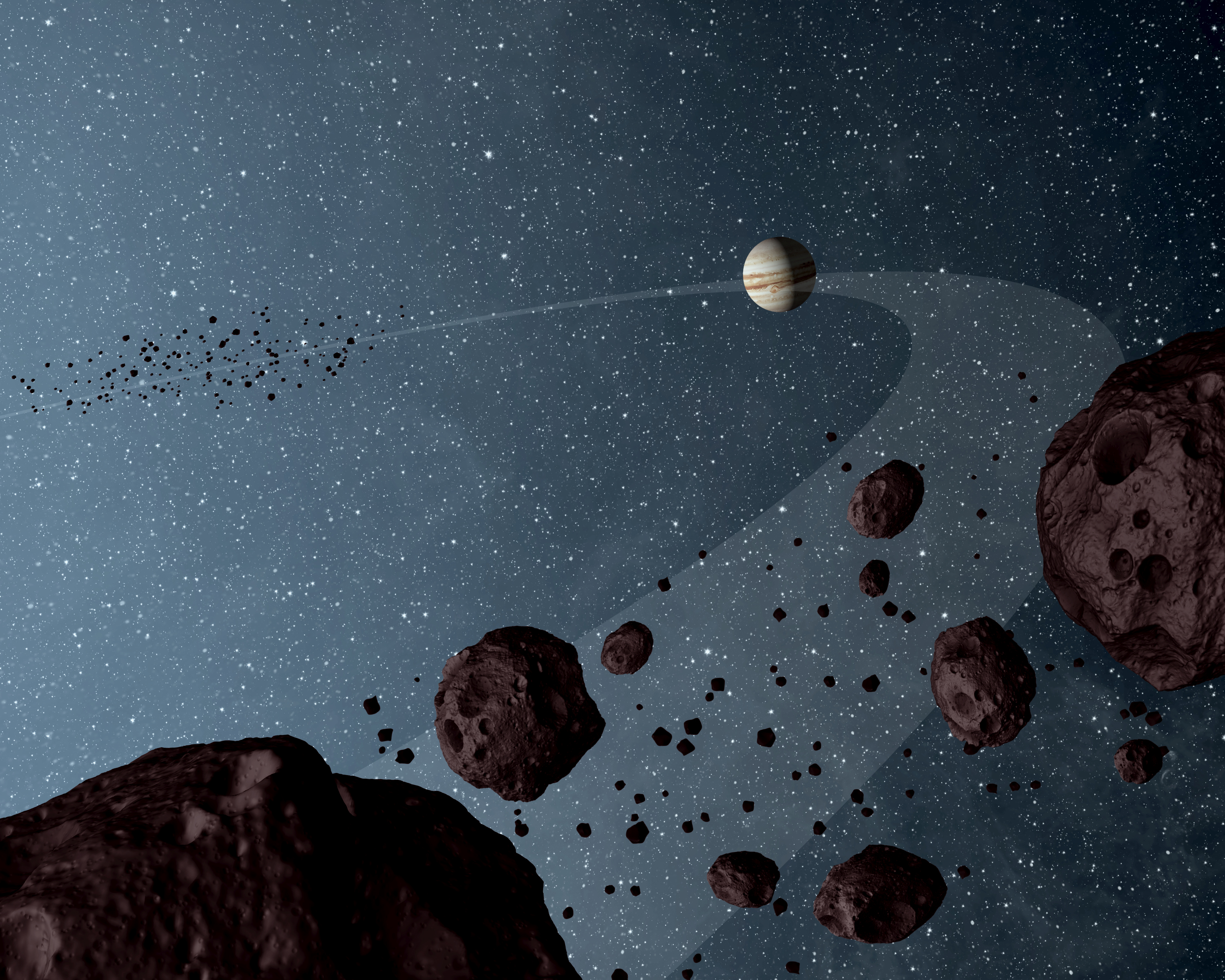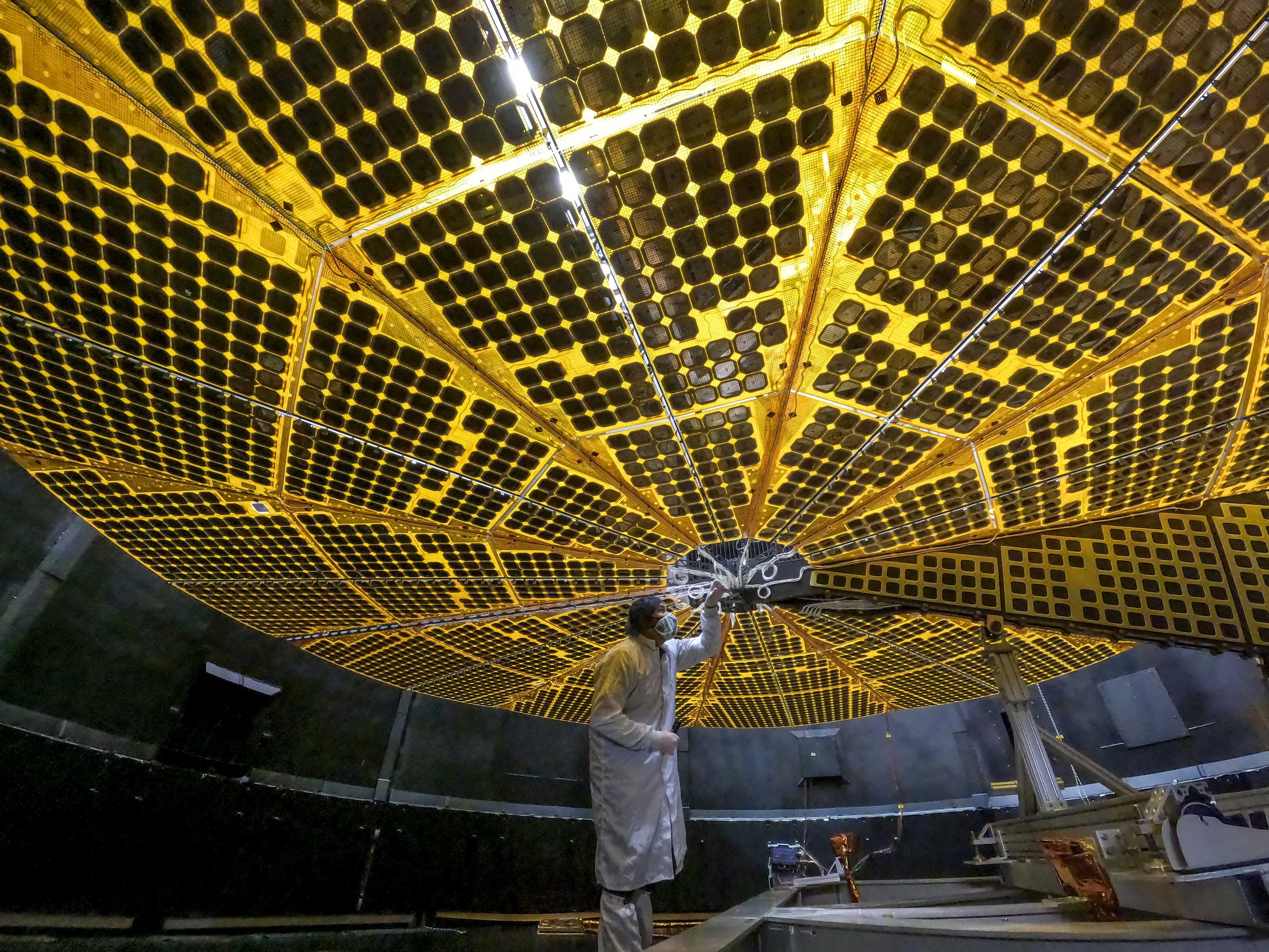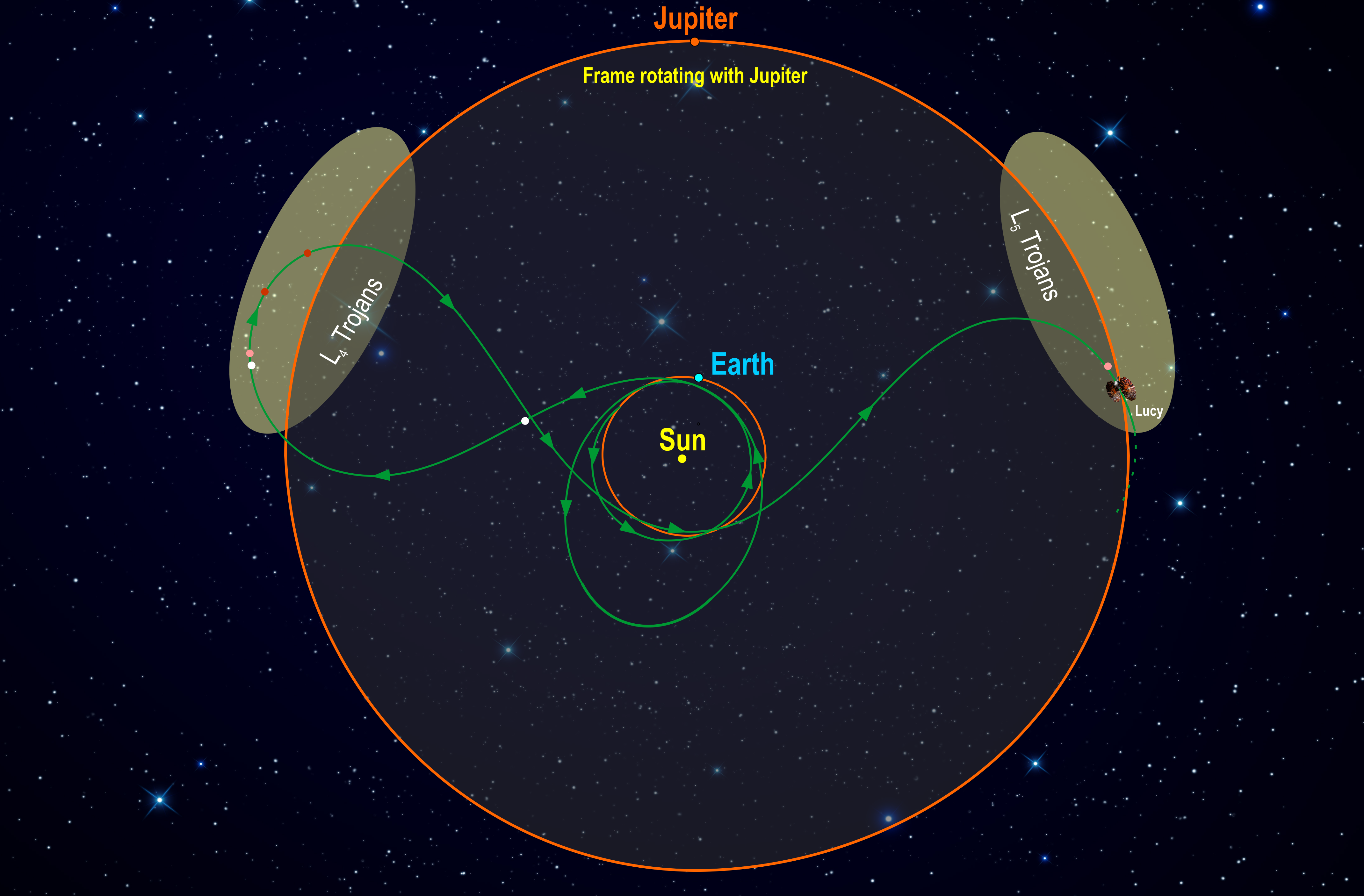NASA's Lucy probe will visit 8 asteroids in 12 years. Here's how it will work.
Visiting eight asteroids in 12 years will take artistry, and an assist from Excel.

Squeezing flybys of eight asteroids, most in a completely unexplored region of space, into just 12 years is a challenge, but that's exactly what NASA's newest mission will do to explore a category of space rock called the Trojans, which cluster ahead of and behind Jupiter in its orbit around the sun.
The spacecraft, dubbed Lucy, will launch on Saturday (Oct. 16) from Cape Canaveral Space Force Station in Florida aboard a United Launch Alliance Atlas V rocket. Liftoff is scheduled for 5:34 a.m. EDT (0934 GMT), and NASA's live coverage will begin at 5 a.m. EDT (0900 GMT); you can watch live at Space.com courtesy of NASA or directly through NASA TV.
Lucy was an unusual challenge for Brian Sutter, a mission architect at aerospace company Lockheed Martin who designed the spacecraft's trajectory, since the team was looking to visit a class of object rather than a specific destination.
"Usually, my job is, 'OK, we want to go to Mars,' and so I know where we're going," he told Space.com. "This one's different because you don't know where you want to go; there's 5,000 options out there."
Related: Meet the 8 asteroids NASA's Lucy spacecraft will visit
But that was Sutter's second challenge. His first was to figure out how to get out to the Trojans at all, since no spacecraft has visited either entourage-like clump of the asteroids: the L4 swarm, which is located about 60 degrees ahead of Jupiter in its orbit, and the L5 swarm, which is found at same distance behind the giant planet.
As he looked at the solar system, Sutter came upon an elegant solution best described as a Trojan cycler. After launch, Lucy will swing by Earth twice to align itself properly, then trek out just past Jupiter's orbit. The outer lobe of this ellipse is carefully designed to align with the L4 swarm of Trojans as it passes through the same location, letting Lucy pick up its first four flybys.
Get the Space.com Newsletter
Breaking space news, the latest updates on rocket launches, skywatching events and more!
(During this outermost part of its orbit, Lucy will also become the solar-powered spacecraft to fly farthest from the sun. It will just nudge out the current record holder, NASA's Juno Jupiter orbiter. The space agency's other missions to the giant-planet realm, such as the Galileo Jupiter probe and the Saturn-studying Cassini, have relied on nuclear power, which is more reliable in the darkness of the outer solar system.)

Then Lucy will loop back into the inner solar system, making another pass of Earth — the first time a spacecraft will ever fly by Earth after having been in the outer solar system. While the spacecraft is closest to Earth, Jupiter is in the same part of space that Lucy flew through during its first flybys.
This Earth flyby will finetune Lucy's course back outward, and by the time it nears the opposite end of its path, it will again be at about the orbital distance of Jupiter, this time just as the L5 swarm that trails the giant planet sweeps through the same region of space.
"From above the solar system looking down, it's just a simple ellipse," Kevin Berry, an aerospace engineer at NASA's Goddard Space Flight Center in Maryland and flight dynamics team leader for the Lucy mission, told Space.com. "The ellipse just repeats every six years, and everything else moves around it."
In fact, the orbit is so stable that Lucy will continue looping between Jupiter's orbit and Earth, popping into the Trojan swarms on alternate passes, for about a million years, the mission team has calculated, giving it the nickname Trojan cycler.
"It's really an artwork," Berry said.
(NASA and the mission team more commonly show an orbital diagram that fixes Jupiter in place, which unstacks and twists the ellipses into interlocking figure 8s in a complicated pattern that Berry said the team calls the "pretzel diagram.")

Related: NASA's Lucy asteroid mission will explore mysteries of the early of solar system
Choosing targets
But getting to the Trojans in general was only one piece of Sutter's challenge: There was still that matter of thousands of potential targets to choose from.
"I didn't know a good Trojan from a bad Trojan," Sutter said.
And Lucy's scientists didn't necessarily have strong preferences on what specific rocks the spacecraft got to see either. But the team did want to visit Trojans that embody the region's diversity, particularly in terms of color, with gray and red asteroids sharing the neighborhood. So Sutter got the science team to put together a list of 20 asteroids in two columns in hopes of flying by any one of each set.
That was the information Sutter needed around 2013 to start looking at specific paths the spacecraft could take. First, pick one asteroid at random from each column of the list and determine which Lucy would need to fly past first. Then, jump to the second flyby and work backward, determining how the first visit would need to go in order to make that flyby happen. Keep sketching out an ellipse based on those two points in time and the basic Trojan cycler design, and see where in the solar system the hypothetical mission could begin.
"I just continued to plot it down to see if it ever came anywhere down close to Earth," Sutter said. "Most of the time, it went off in some weird direction." But finally, he hit a pair that worked, Eurybates and Orus. These two Trojans are both located in the L4 swarm, ahead of Jupiter in its orbit, and are about the same size, with diameters around 40 miles (64 kilometers) or so, but Eurybates is gray while Orus is quite red.
"That trajectory, when I flew it backwards in time, it ended up pretty close to Earth," Sutter said. "So I was thrilled."
Those two flybys formed the backbone of the mission, but Sutter's goal when he came up with the Trojan cycler ellipse idea was to fit, say, four or five asteroids into the mission to give scientists the range of space rocks they were truly looking for.
And, of course, the Trojan swarms are mostly empty space. "I will say there is a misconception that flying through the Trojan asteroid swarms or even the main belt asteroids is like 'Star Wars,'" Cathy Olkin, the mission's deputy principal investigator and a planetary scientist at the Southwest Research Institute (SwRI) in Colorado, told Space.com. "We're not having to dodge asteroids like they show in the movies."
So finding additional asteroids does take work, but it's feasible.
"We want to get diversity, and we've got I think it's on the order of a year and a half between those encounters, so I bet you there's stuff in between that we're also just sort of flying by accidentally, so to speak," Sutter said of his thinking. "And in fact that leg of the trajectory that goes from Earth to Eurybates — that's flying through the main belt asteroids, so I bet you there's stuff in there, too, that we're flying close to."
May as well check.
So, Sutter dumped the orbital characteristics of some 750,000 asteroids into an Excel file.
You read that right.
"As it so happens, I basically took Excel — you know, the spreadsheet program that we all use for our budgets and taxes and everything else — and I put an orbit propagator into Excel," he said. As one does.
Sutter designed a system that would take a basic orbit and run through all those asteroids, identifying what was nearby. "I'd just wait until the end of the day and I'd push the button when I was going home from work in the evening," he said. "It would run all night long, and I'd come in in the morning and there'd be a little surprise for me."
Within two months, he had designed Lucy's itinerary to fly past seven different asteroids. (After that agenda was confirmed, scientists identified a small moon now called Queta orbiting Lucy's first Trojan target, Eurybates, which the mission team hopes to observe as well, bringing the probe's target tally to eight.) Within six months, Sutter had fine-tuned the orbit, with all the maneuvers necessary to observe each object determined.
"We're on a knife's edge on the trajectory and cannot vary one iota from what we're going to do," Hal Levison, the mission's principal investigator and another planetary scientist at SwRI, told Space.com.
Since Sutter put the mission plan together, researchers at NASA Goddard developed a system that can automatically run through essentially the same process. "That tool can do what I did in a week's worth of optimization, it can do in a half hour," Sutter said of the program.
The team had the system take a crack at a Trojan asteroid mission too, just in case. "At the end of the day, it was no, we can't find anything better than the original trajectory," he said of that review. "That's the one that we should propose; that's the best one."
And so that's the trajectory that Lucy will fly after launch: Two passes of Earth to speed up the spacecraft, then out to cycle through the Trojans. All told, the mission is planned to last 12 years, during which it will observe eight asteroids, including a wide variety of Trojans.
"The planets are literally aligning to allow us to do this," Levison said. "The celestial mechanics gods are really smiling on this mission."
Email Meghan Bartels at mbartels@space.com or follow her on Twitter @meghanbartels. Follow us on Twitter @Spacedotcom and on Facebook.
Join our Space Forums to keep talking space on the latest missions, night sky and more! And if you have a news tip, correction or comment, let us know at: community@space.com.

Meghan is a senior writer at Space.com and has more than five years' experience as a science journalist based in New York City. She joined Space.com in July 2018, with previous writing published in outlets including Newsweek and Audubon. Meghan earned an MA in science journalism from New York University and a BA in classics from Georgetown University, and in her free time she enjoys reading and visiting museums. Follow her on Twitter at @meghanbartels.









